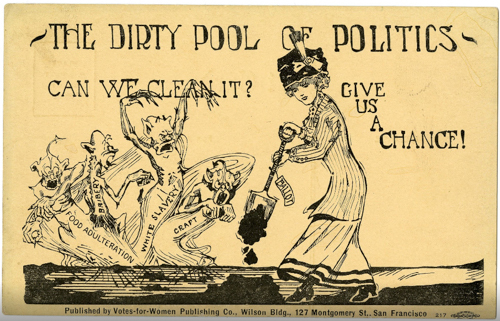Sample Analysis I: Divide it Up!
Description of the Cartoon:
This cartoon, which is called "The Dirty Pool of Politics," shows a fashionably dressed woman wears an elaborate hat and very up-to-date and trendy clothes with a shovel, and she's shoveling dirt in front of her as she goes and the dirt is characterized as "White Slavery," Graft, Food Adulteration which are the problems of the city, of the moment.
The Point of the Cartoon:
The point of the cartoon—which says, "Can we clean it? Give us a chance"—is to talk about how women are imagined as having a greater instinct for cleaning, a greater commitment to it, and investment of it, a set of skills and experiences that allows them to be, not only the cleaners of their own homes, but municipal housecleaners. This is a very prominent theme by the 1890s and by 1900, when suffrage becomes once again on the public consciousness and you see the merging of the two kind of rival suffrage associations—the NWSA [National Woman Suffrage Association] and the American Women's Suffrage Association—the national and the American. This is what they're going to, in a large part, base their rationale on.
The Change of Strategy To Fight For The Right To Vote:
So instead of what we had seen for most of the second half of the 19th century, which was an emphasis on the human right to political participation that should be shared equally by men and women, so a principle, you see a change in tactics. Not that many of the suffragists actually gave up thinking along those lines, but they certainly switched rhetoric to something they felt would be more practical, more pragmatic, and some historians have used the term expedient. The one closest to hand was the idea that women are responsible for the home and in an industrialized context the home is no longer a private domicile that a woman has control over the quality of. So if you want to be able to clean up your home, if you want—one of the things in this cartoon was food adulteration, you want to make sure that the meat that your serving your children is healthy and not rotten, that the fruit is clean and hasn't been soiled by being sitting out in an open market, if you want to make sure that the water coming into the home does not have disease in it, does not have airborne or waterborne diseases. All of those things [are] going to require the woman to actually step out of the private sphere and into the public sphere and have some political participation and some influence and control.
Conclusion:
So this cartoon shows you right at the beginning of that movement the opportunity that women are seizing upon. To say we require the vote in order to be the traditional mothers and homemakers that we agree we primarily are. It's a very powerful and very effective and strategic argument and a cartoon like this says it in a very short punchy way.
source: https://teachinghistory.org/best-practices/examples-of-historical-thinking/25634
